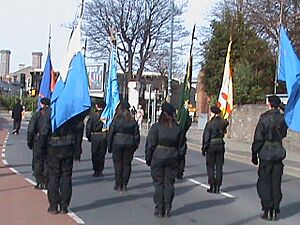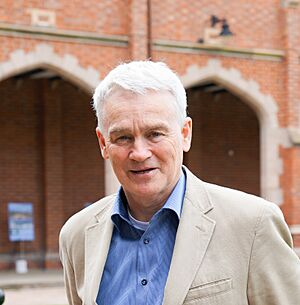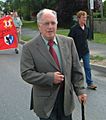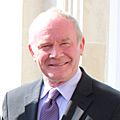Provisional Irish Republican Army facts for kids
Quick facts for kids Provisional Irish Republican Army |
|
|---|---|
| Irish: Óglaigh na hÉireann | |
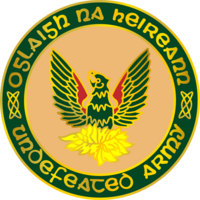
A Provisional IRA badge, with the phoenix symbolising the group's origins.
|
|
| Leaders | IRA Army Council |
| Dates of operation | 1969–2005 (on ceasefire from 1997) |
| Allegiance | |
| Active regions | Ireland, England, Europe, |
| Ideology |
|
| Size | 10,000 est. throughout the Troubles |
| Allies |
|
| Opponents | Ulster loyalist paramilitaries
|
| Battles and wars | The Troubles |
|
|
|
The Provisional Irish Republican Army (Provisional IRA), officially known as the Irish Republican Army (IRA; Irish: Óglaigh na hÉireann) and informally known as the Provos, was an Irish republican paramilitary force that sought to end British rule in Northern Ireland, facilitate Irish reunification and bring about an independent republic encompassing all of Ireland. It was the most active republican paramilitary group during the Troubles. It argued that the all-island Irish Republic continued to exist, and it saw itself as that state's army, the sole legitimate successor to the original IRA from the Irish War of Independence. It was designated a terrorist organisation in the United Kingdom and an unlawful organisation in the Republic of Ireland, both of whose authority it rejected.
Contents
History
The Provisional IRA emerged in December 1969, due to a split within the previous incarnation of the IRA and the broader Irish republican movement. It was initially the minority faction in the split compared to the Official IRA but became the dominant faction by 1972. The Troubles had begun shortly before when a largely Catholic, nonviolent civil rights campaign was met with violence from both Ulster loyalists and the Royal Ulster Constabulary (RUC), culminating in the August 1969 riots and deployment of British soldiers. The IRA initially focused on defence of Catholic areas, but it began an offensive campaign in 1970 that was aided by external sources, including Irish diaspora communities within the Anglosphere, and the Palestine Liberation Organization and Libyan leader Muammar Gaddafi. It used guerrilla tactics against the British Army and RUC in both rural and urban areas, and carried out a bombing campaign in Northern Ireland and England against military, political and economic targets, and British military targets in mainland Europe. They also targeted civilian contractors to the British security forces. The IRA's armed campaign, primarily in Northern Ireland but also in England and mainland Europe, killed over 1,700 people, including roughly 1,000 members of the British security forces and 500–644 civilians.
The Provisional IRA declared a final ceasefire in July 1997, after which its political wing Sinn Féin was admitted into multi-party peace talks on the future of Northern Ireland. These resulted in the 1998 Good Friday Agreement, and in 2005 the IRA formally ended its armed campaign and decommissioned its weapons under the supervision of the Independent International Commission on Decommissioning. Several splinter groups have been formed as a result of splits within the IRA, including the Continuity IRA, which is still active in the dissident Irish republican campaign, and the Real IRA.
Structure
All levels of the organisation were entitled to send delegates to General Army Conventions. The convention was the IRA's supreme decision-making authority, and was supposed to meet every two years, or every four years following a change to the IRA's constitution in 1986. Before 1969 conventions met regularly, but owing to the difficulty in organising such a large gathering of an illegal organisation in secret, while the IRA's armed campaign was ongoing they were only held in September 1970, October 1986, and October or November 1996. After the 1997 ceasefire they were held more frequently, and are known to have been held in October 1997, May 1998, December 1998 or early 1999, and June 2002. The convention elected a 12-member Executive, which selected seven members, usually from within the Executive, to form the Army Council. Any vacancies on the Executive would then be filled by substitutes previously elected by the convention. For day-to-day purposes, authority was vested in the Army Council which, as well as directing policy and taking major tactical decisions, appointed a chief-of-staff from one of its number or, less often, from outside its ranks.
The chief-of-staff would be assisted by an adjutant general as well as a General Headquarters (GHQ) staff, which consisted of a quartermaster general, and directors of finance, engineering, training, intelligence, publicity, operations, and security. GHQ's largest department, the quartermaster general's, accounted for approximately 20% of the IRA's personnel, and was responsible for acquiring weapons and smuggling them to Ireland where they would be hidden in arms dumps, and distributed them to IRA units as needed. The next most important department was engineering, which manufactured improvised explosive devices and improvised mortars. Below GHQ, the IRA was divided into a Northern Command and a Southern Command. Northern Command operated in Northern Ireland as well as the border counties of Donegal, Leitrim, Cavan, Monaghan, and Louth, while Southern Command operated in the remainder of Ireland. In 1977, parallel to the introduction of cell structures at the local level, command of the "war-zone" was given to the Northern Command, which facilitated coordinated attacks across Northern Ireland and rapid alterations in tactics. Southern Command consisted of the Dublin Brigade and a number of smaller units in rural areas. Its main responsibilities were support activities for Northern Command, such as importation and storage of arms, providing safe houses, raising funds through robberies, and organising training camps. Another department attached to GHQ but separate from all other IRA structures was the England department, responsible for the bombing campaign in England.
The IRA referred to its ordinary members as volunteers (or óglaigh in Irish), to reflect the IRA being an irregular army which people were not forced to join and could leave at any time. Until the late 1970s, IRA volunteers were organised in units based on conventional military structures. Volunteers living in one area formed a company as part of a battalion, which could be part of a brigade, such as the Belfast Brigade, Derry Brigade, South Armagh Brigade, and East Tyrone Brigade. In late 1973 the Belfast Brigade restructured, introducing clandestine cells named active service units, consisting of between four and ten members. Similar changes were made elsewhere in the IRA by 1977, moving away from the larger conventional military organisational principle owing to its security vulnerability. The old structures were used for support activities such as policing nationalist areas, intelligence-gathering, and hiding weapons, while the bulk of attacks were carried out by active service units, using weapons controlled by the brigade's quartermaster. The exception to this reorganisation was the South Armagh Brigade, which retained its traditional hierarchy and battalion structure. Only a handful of volunteers from the South Armagh Brigade were convicted of serious offences, and it had fewer arrests than any other area, meaning that the security forces struggled to recruit informers.
Casualties
The IRA was responsible for more deaths than any other organisation during the Troubles. Two detailed studies of deaths in the Troubles, the Conflict Archive on the Internet (CAIN), and the book Lost Lives, differ slightly on the numbers killed by the IRA and the total number of conflict deaths. According to CAIN, the IRA was responsible for 1,705 deaths, about 48% of the total conflict deaths. Of these, 1,009 (about 59%) were members or former members of the British security forces, while 508 (about 29%) were civilians. According to Lost Lives, the IRA was responsible for 1,781 deaths, about 47% of the total conflict deaths. Of these, 944 (about 53%) were members of the British security forces, while 644 (about 36%) were civilians (including 61 former members of the security forces). The civilian figure also includes civilians employed by British security forces, politicians, members of the judiciary, and alleged criminals and informers. Most of the remainder were loyalist or republican paramilitary members. Overall, the IRA was responsible for 87–90% of the total British security force deaths, and 27–30% of the total civilian deaths.
During the IRA's campaign in England it was responsible for at least 488 incidents causing 2,134 injuries and 115 deaths, including 56 civilians and 42 British soldiers. Between 275 and 300 IRA members were killed during the Troubles, with the IRA's biggest loss of life in a single incident being the Loughgall ambush in 1987, when eight volunteers attempting to bomb a police station were killed by the British Army's Special Air Service.
Images for kids
-
The Proclamation of the Irish Republic, issued during the 1916 Easter Rising against British rule in Ireland
-
Ruairí Ó Brádaigh, who was twice chief-of-staff of the pre-1969 IRA during the Border campaign of 1956–1962, was a member of the first Army Council of the Provisional IRA in 1969.
-
Martin McGuinness was part of an IRA delegation which took part in peace talks with British politician William Whitelaw, the Secretary of State for Northern Ireland, in July 1972.
-
Memorial to the victims of the Birmingham pub bombings, which killed twenty-one people in November 1974
See also
 In Spanish: Ejército Republicano Irlandés Provisional para niños
In Spanish: Ejército Republicano Irlandés Provisional para niños


